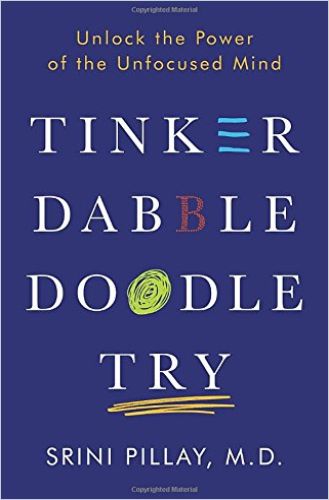People imagine they might achieve their dreams if they could simply focus more, but what if the inverse were true? In Tinker, Dabble, Doodle, Try, psychiatrist and brain researcher Srini Pillay suggests that the key to unlocking your brain’s full potential lies in learning to “unfocus.”

Harnessing the wandering mind
Many people believe that success hinges on the ability to concentrate, but according to Srini Pillay, they should instead learn to focus less. Drawing on the latest findings in neuroscience and case studies from his own practice as a brain researcher as well as business, the arts, education and sports, Pillay suggests that leveraging the wandering mind will help steer you toward your dream life. Over six chapters and a concluding “Tinker Manifesto,” Pillay shares tips to help you tap into your brain’s powerful but often neglected unfocus circuit, allowing you to embrace dynamic learning, trigger creativity and become a better multitasker.
Focus traps
Research shows that, when you focus, your perspective narrows, and you develop what psychologists call “inattentional blindness,” meaning you miss broader details outside your honed-in viewpoint. As Pillay explains, this hyperfocus can be extremely useful, for example when you’re trying to complete a task quickly. Yet the selective attention caused by overfocusing can also make you less likely to help others and hinder your ability to take in all the relevant information.
Spending too much time in a focused state will also exhaust your brain’s mental capacities. Neuroscience shows that, in contrast, “unfocusing” creates activity in a region of your brain that activates during rest and deactivates when you focus: the default mode network (DMN) or, as Pillay calls it, the “unfocus circuit”.
Unfocus is an intelligent form of letting go.Srini Pillay
Unfocusing causes your brain to rest and recharge as it reduces amygdala activity and stress. It also boosts innovation by activating your frontopolar cortex, giving you new insights and perspectives. Pillay suggests that if you train your brain to activate your DMN, you’ll become a more effective and nimble thinker and problem solver. You’ll find the activities he recommends easy enough: Take a break, go for a walk, do some gardening or lie in a hammock. These and similar activities allow your mind to wander, daydream and imagine.
Finding your sweet spot
Pillay doesn’t advocate abandoning focus. Rather, he shows that you need to find a healthy balance between times of focus and unfocus. Since mindfulness requires practice, activating your unfocus circuit takes time and effort. The brain resists change, and forming new habits can create cognitive dissonance. To overcome this psychological discomfort, Pillay encourages readers to see it as “switch costs”: the price you pay to make beneficial changes in your routine.
Your brain rebels against change, even if it is good for you, and irrationally tries to stay stuck. Stuckness can feel safer than change.Srini Pillay
Many people run from stress or tension, thus curtailing their options by shrinking the scope of their dreams. Yet as Pillay points out, self-actualization requires some degree of tension and anxiety, because these forces help forge your personality. Psychiatrist Kazimierz Dabrowski calls this phenomenon “positive disintegration.” Pillay encourages his readers to persevere through these difficult stages by engaging in positive self-talk, recognizing that current circumstances don’t determine the future and scheduling some stress-free activities into your days.
Dynamic learning at the center
People used to believe that you had to learn in a linear, focused way to acquire new skills and knowledge. However, Pillay suggests that dynamic learning based on lateral creative thinking – and switching between focused and unfocused states – is more effective. He lists four action steps, the “four Cs,” that can help people become more adept learners: “change direction” – take time to turn your attention inwards; “be curious” – if your innate interests drive you, you’ll learn more easily; “curate advice” – allow yourself to discard others’ advice at the risk of making mistakes; and “co-construct learning” – embrace the aspects of your learning process that are uniquely human.
Unfocused
Srini Pillay offers a wealth of advice and plenty of insights into how you can learn to let your mind wander and thereby unlock your creativity. So, it may be fitting that the book itself meanders from psychological case studies and neuroscientific findings toward less ground-breaking self-help advice and practical tips to unwind. Pillay himself describes his approach to personal development and goal mastery as one that “blends science, spirituality and horns-grabbing joie de vivre.” While Pillay’s approach and style might not suit every reader, many will benefit from reflecting on his main premise: Sometimes, it’s best to zoom out, let the mind drift and allow yourself to experiment.








